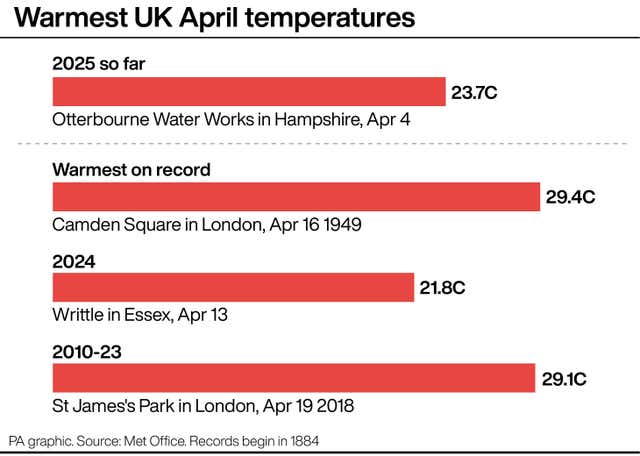Heavy rain to reduce risk of wildfires following possible hottest day of year
Highs of 24C are forecast for parts of the UK on Friday and Saturday.

Heavy rain and cooler temperatures are expected to follow what could be the hottest day of the year and help reduce the risk of wildfires.
Highs of 24C are forecast for parts of the UK on Friday and Saturday, but a change in the weather pattern will bring downpours over the weekend and into next week.
It will be welcome relief for some areas of the country where firefighters have been battling large wildfires amid the recent period of warm weather.
The hottest day of the year so far was on April 4 with a high of 23.7C in Otterbourne, Hampshire.

Met Office spokesperson Grahame Madge said temperatures could surpass this in east and south-east England on Friday.
“London is probably in with the shout of being one of the highest,” he said.
“St James’s Park, maybe Kew Gardens, that sort of area of west London, will have the highest values.
“But quite widely, we’ll see temperatures today up into the 20s, particularly for areas away from the West.”
He added that if 24C is not seen on Friday, there is a chance that areas such as East Anglia, Kent and across the Home Counties could reach it on Saturday as this area “will hang on to the heat for the longest amount of time”.
The warmest April temperature on record was 29.4C in London in 1949.
Fire chiefs have warned against using barbecues during the warm spell because of a heightened wildfire risk due to low rainfall.
An “extreme” wildfire warning was issued in Scotland, with firefighters remaining at the scene of a wildfire on the Isle of Arran, to the north-west of Brodick, as well as one in the Cumbernauld area of North Lanarkshire which broke out on Thursday evening.
Michael Humphreys, national wildfire lead for the Scottish Fire and Rescue Service, said he hoped the warning would “make people think if they are going out to enjoy the countryside, to act responsibly, and stop a fire from starting in the first place”.
Wildfire warnings are also in place for London and Yorkshire, with firefighters tackling a blaze on Marsden Moor in the South Pennines, between West Yorkshire and Greater Manchester.
According to the National Fire Chiefs Council (NFCC), fire and rescue services in England and Wales have responded to 380 wildfires so far this year – more than double the number for the same period in 2022, which went on to be a record year.
NFCC chairman Phil Garrigan said: “We want people to enjoy this lovely weather, we are just asking that they take extra care. One inconsiderate action or small mistake can have huge consequences when it comes to wildfires, so we are asking that people follow this important advice so that they can keep themselves and everyone else safe.”
The Met Office said that with the change in weather “meteorologically, we’re moving away from the conditions that have led to the wildfires taking place over the last 10 days or so”.
Mr Madge added: “Conditions will obviously be changing given the unsettled nature, so we’ll be transitioning to the cooler conditions and some rainfall, which will further suppress any risks of wildfire.”
This is “not in any way dreadful weather. It’s just going to be a change from what we’ve experienced”, he added.
“If you can avoid the showers, then it will still be nice.”
There is also a chance of thunderstorms over the weekend across the South West and western Wales.
During Easter week, children on school holidays may be disappointed as an area of low pressure will bring more rain, which could be heavy in parts.
The unsettled weather is expected to last at least 10 days or more, the Met Office said, longer than initially predicted.
It is looking to be rainier than last month, when historically low rainfall saw England have its sixth driest March since records began in 1836.
The Royal Life Saving Society UK (RLSS UK) has urged the public to be safe around water if taking a dip while the warm weather lasts.
Research from the charity found that when temperatures reach 21C to 22.9C, 2.5 times as many drownings occur each day, in comparison to cooler days.





